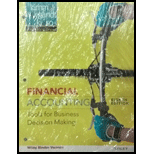
(a)
Accounting Equation: It is the mathematical equation that shows the relation between assets, liabilities and stockholders’ equity. It shows that assets balances the liabilities / stockholders’ equity. It is expressed as:
Accounting Equation

Figure (1)
The amount of stockholders’ equity at the end of the year. Follow the below equation to determine the value of stockholders’’ equity:
(a)
Accounting Equation: It is the mathematical equation that shows the relation between assets, liabilities and stockholders’ equity. It shows that assets balances the liabilities / stockholders’ equity. It is expressed as:
Accounting Equation

Figure (1)
Answer to Problem 1.9BE
Total assets at the end of the year = $950,000 (1)
Total liabilities at the end of the year = $420,000 (2)
Determine the amount of stockholders’ equity at the end of the year.
Working Notes:
Determine the amount of total assets at the end of the year.
Determine the amount of total liabilities at the end of the year.
Explanation of Solution
To determine the total stockholder’s equity, first determine total assets and total liabilities at the end of the year. Total assets at the end of the year are determined by adding the total assets at the beginning of the year, and total assets increased during the year. Then total liabilities are determined by deducting the total liabilities at the beginning of the year, and total liabilities decreased during the year.
Therefore, the stockholders’ equity at the end of the year of Company M is $530,000.
(b)
The amount of total assets at the end of the year. Follow the below equation to determine the value of assets:
(b)
Answer to Problem 1.9BE
Total stockholders’ equity at the end of the year = $230,000 (3)
Total liabilities at the end of the year = $600,000 (4)
Determine the amount of total assets at the end of the year.
Working Notes:
Determine the amount of stockholders’ equity at the beginning of the year.
Determine the amount of total stockholders’ equity at the end of the year.
Determine the amount of total liabilities at the end of the year.
Explanation of Solution
To determine the total assets, first determine total stockholders’ equity and total liabilities at the end of the year. Total stockholders’ equity at the end are determined by deducting the beginning stockholders’ equity of the year and decreased stockholders’ equity during the year. Then total liabilities are determined by adding the total liabilities at the beginning of the year and total liabilities increased during the year.
Therefore, the total asset at the end of the year of Company M is $830,000.
(c)
The amount of total liabilities at the end of the year. Follow the below equation to determine the value of liabilities:
(c)
Answer to Problem 1.9BE
Total assets at the end of the year = $720,000 (5)
Total stockholders’ equity at the end of the year = $410,000 (6)
Determine the amount of total liabilities at the end of the year.
Working Notes:
Determine the amount of stockholders’ equity at the beginning of the year.
Determine the amount of total assets at the end of the year.
Determine the amount of stockholders’ equity at the end of the year.
Explanation of Solution
To determine the total liabilities, first determine total assets and total stockholders’ equity at the end of the year. Total assets at the end of the year are determined by deducting the total assets at the beginning of the year and total assets decreased during the year. Then total stockholders’ equity at the end are determined by adding the beginning stockholders’ equity of the year and increased stockholders’ equity during the year.
Therefore, the total liability at the end of the year of Company M is $310,000.
Want to see more full solutions like this?
Chapter 1 Solutions
Bundle: Financial Accounting: Tools for Business Decision Making 8e Binder Ready Version + WileyPLUS Registration Code
- I am looking for the correct answer to this general accounting question with appropriate explanations.arrow_forwardOn May 1st, Golden Harvest, Inc. purchased $1,500 worth of supplies on account. On December 31st, the fiscal year-end for Golden Harvest, it is determined that $800 worth of supplies still remain. What is the balance in the supplies account after adjustment?arrow_forwardBeginning inventory 53000, ending inventory 60000arrow_forward
- I need help finding the accurate solution to this general accounting problem with valid methods.arrow_forwardMathur Manufacturing uses a job order costing system. During one month, Mathur purchased $188,000 of raw materials on credit; issued materials to the production of $263,000 of which $17,000 were indirect. Mathur incurred a factory payroll of $172,000, of which $25,000 was indirect labor. Mathur uses a predetermined overhead rate of 150% of direct labor cost. The total manufacturing costs added during the period are_.arrow_forwardI need help solving this general accounting question with the proper methodology.arrow_forward
- I am looking for help with this general accounting question using proper accounting standards.arrow_forwardDuring FY 2005 Plastic Manufacturing had total manufacturing costs are $418,000. Their cost of goods manufactured for the year was $448,000. The January 1, 2006 balance of the Work-in-Process Inventory is $49,000. Use this information to determine the dollar amount of the FY 2005 beginning Work-in-Process Inventory.arrow_forwardPlease explain this financial accounting problem by applying valid financial principles.arrow_forward
 Managerial Accounting: The Cornerstone of Busines...AccountingISBN:9781337115773Author:Maryanne M. Mowen, Don R. Hansen, Dan L. HeitgerPublisher:Cengage Learning
Managerial Accounting: The Cornerstone of Busines...AccountingISBN:9781337115773Author:Maryanne M. Mowen, Don R. Hansen, Dan L. HeitgerPublisher:Cengage Learning Intermediate Financial Management (MindTap Course...FinanceISBN:9781337395083Author:Eugene F. Brigham, Phillip R. DavesPublisher:Cengage LearningPrinciples of Accounting Volume 1AccountingISBN:9781947172685Author:OpenStaxPublisher:OpenStax College
Intermediate Financial Management (MindTap Course...FinanceISBN:9781337395083Author:Eugene F. Brigham, Phillip R. DavesPublisher:Cengage LearningPrinciples of Accounting Volume 1AccountingISBN:9781947172685Author:OpenStaxPublisher:OpenStax College EBK CONTEMPORARY FINANCIAL MANAGEMENTFinanceISBN:9781337514835Author:MOYERPublisher:CENGAGE LEARNING - CONSIGNMENT
EBK CONTEMPORARY FINANCIAL MANAGEMENTFinanceISBN:9781337514835Author:MOYERPublisher:CENGAGE LEARNING - CONSIGNMENT Financial AccountingAccountingISBN:9781337272124Author:Carl Warren, James M. Reeve, Jonathan DuchacPublisher:Cengage Learning
Financial AccountingAccountingISBN:9781337272124Author:Carl Warren, James M. Reeve, Jonathan DuchacPublisher:Cengage Learning




